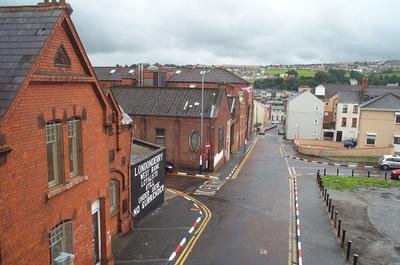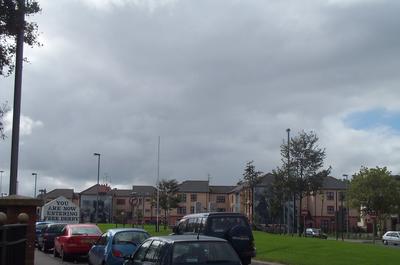| Revision as of 13:48, 2 April 2004 view sourceHenrygb (talk | contribs)12,381 editsmNo edit summary← Previous edit | Revision as of 15:38, 22 April 2004 view source Dale Arnett (talk | contribs)Administrators294,789 editsmNo edit summaryNext edit → | ||
| Line 48: | Line 48: | ||
| There are also places named both '''Derry''' and '''Londonderry''' in the ] of ] in the ]: | There are also places named both '''Derry''' and '''Londonderry''' in the ] of ] in the ]: | ||
| *] | *] | ||
| *] | *] | ||
| (Note that these are ''different'' places.) | (Note that these are ''different'' places.) | ||
Revision as of 15:38, 22 April 2004

Derry, or Londonderry (Doire in Irish) is a city in Northern Ireland, in County Londonderry (or County Derry). The old walled city of Londonderry lies on the west bank of the River Foyle, but the city has now covers both banks and is connected by two bridges. Derry is near the border with the Republic of Ireland, and serves much of North Donegal, as well as the west of the county of Londonderry. Also known as the Maiden City, it is Northern Ireland's second largest city.
The name
The city's name is a subject of dispute between nationalists (mostly Catholic) and unionists (most of whom are Protestant), with nationalists calling it Derry, and unionists, Londonderry. Although many unionists will call it Derry in casual conversation, they generally insist on calling it Londonderry during political discourse; the reverse is not true of nationalists.
The city council is controlled by nationalist parties, and has officially changed its name to Derry City Council. Technically, however, the name of the city is still specified by its Royal Charter as Londonderry, and many unionists continue to call it Londonderry regardless. A suggested compromise wording of "Derry/Londonderry" (read "Derry stroke Londonderry") has given rise to the ironic local usage "Stroke City". Gerry Anderson, a local radio presenter who espoused this term, became known briefly as "Gerry/Londongerry". Another locally-used method of partly circumventing this name problem is to write "L'derry" or "L-Derry" etc.

The "No Surrender" graffito right outside the city wall: "LONDONDERRY | WEST BANK | LOYALISTS | STILL | UNDER SIEGE | NO SURRENDER"
The name Derry is an anglicisation of the Irish name, Doire ("oak grove"). When the city was rebuilt by The Honourable The Irish Society using donations from the City of London during the Plantation by English and Scottish settlers, it was renamed Londonderry. Nationalists, however, do not accept the change of name.
History
Derry is one of the longest continuously inhabited places in Ireland. The earliest historical references date to the sixth century A.D. when a monastery was founded there, but for thousands of years before that people had been living in the vicinity. These 'prehistoric' people left traces of their existence in the various archaeological sites and objects which often come to light in this area.
In the 6th century A.D. a Christian monastery was founded on the hill of Derry. The site was allegedly granted by a local king who had a fortress there. A similar kind of fortress can be seen at the spectacular Grianan of Aileach, a few miles west of the city and now in County Donegal. According to legend the monastery of Derry was established by the great Irish saint Colmcille/Columba (521-597). Colmcille founded many important monasteries in Ireland and Britain, including Durrow in the Irish midlands and Iona on an island off the west of Scotland. The claim that he founded Derry is less certain, although that monastery definitely belonged to the federation of Columban churches which looked to Colmcille as their spiritual founder and leader. The monastery of Derry would have been quite small at the beginning. The location of the first church was probably where the beautiful little Church of Ireland Chapel of St Augustine stands today. During the later middle ages the old monastery of Derry evolved into an Augustinian congregation. The church of that monastery survived up to the seventeenth century and was used, as their first place of worship, by the London colonists who came here to build the walled city.
Although the Vikings certainly sailed up the loughs and rivers of this area, the monastery of Derry escaped the worst effects of their raids. Derry's medieval heydays were in the 12th centuries and 13th centuries when the local Mac Lochlainn dynasty moved into the settlement. Under their patronage, Derry prospered: the population grew; the monastery and its school thrived; and prestigious buildings were erected. With the decline of the Mac Lochlainns, some of whom claimed to be kings of all Ireland, Derry also sank into unimportance.
Throughout the second half of the 16th century, Queen Elizabeth I's military leaders tried to conquer the province of Ulster, the only part of Ireland still outside English control. The English first came to Derry in 1566 but the garrison established there at that time lasted only a few years. A second, more successful garrison returned in 1600 during the 'Nine Years War' against the Gaelic O'Neill and O'Donnell earls. On this occasion the English managed to hold on to Derry and, when the war came to an end in 1603, a small trading settlement was established and given the legal status of city. In 1608 this 'infant city' was attacked by Sir Cahir O'Doherty (a previous supporter of the English in Ulster), and the settlement was virtually wiped out.
This attack came about shortly after the so-called 'flight of the earls' when the O'Neill and O'Donnell chieftains, together with their principal supporters, fled to the continent, leaving Gaelic Ulster leaderless. The new king in London, James I, decided on a revolutionary plan designed once and for all to subordinate Ulster. The 'Plantations in Ulster' required the colonising of the area by loyal English and Scottish migrants who were to be predominantly Protestant in religion, unlike the Catholic Irish. One part of this colonisation was to be organized by the ancient and wealthy livery companies of the City of London. The new county granted to the Londoners and its fortified city, built across the river Foyle from the recently destroyed settlement, were renamed Londonderry in honour of this association . The city of Londonderry was the jewel in the crown of the Ulster plantations. It was laid out according to the best contemporary principles of townplanning, imported from the continent (the original street lay-out has survived to the present almost intact). More importantly, the city was enclosed by massive stone and earthen fortifications. Derry was the last walled city built in Ireland and the only city on the island whose ancient walls survive complete. Among the city's new buildings was St. Columb's Cathedral (1633). This is one of the most important seventeenth century buildings in the country and was the first specifically Protestant cathedral erected in these islands following the Reformation.
The new city was slow to prosper. By the 1680s it still had only about 2,000 inhabitants; and yet it was, by far, the largest town in Ulster. Along with most parts of Britain and Ireland, the city suffered from the upheavals in the 1640s. In 1649 the city and its garrison, which supported the 'republican' Parliament in London, were besieged by Scottish Presbyterian forces loyal to King Charles I. Among its most famous citizens in the second half of the seventeenth century was George Farquhar, one of the so-called Restoration dramatists.
On April 18, 1689, while attempting to regain his throne during the "Glorious Revolution", James II came to Derry and summoned the city to surrender. The King was rebuffed and actually fired at by some of the more determined defenders; tradition has the apprentice boys closing the gates and saving the city. As a policy of 'no surrender' was confirmed, the Jacobite forces outside the city began the famous Siege of Derry. For 105 days the city suffered appalling conditions as cannonballs and mortar-bombs rained down, and famine and disease took their terrible toll. Conditions for the besiegers were no better and many thousands of people died, both inside and outside the walls. The cannons used to defend the city can be seen on the walls and at other places around the city. Finally at the end of July, a relief ship broke the barricading 'boom' which had been stretched across the river, near where the new Foyle Bridge now stands. The Siege was over but it has left its mark on the traditions of the city to the present day.
The city was rebuilt in the 18th century with many of its fine Georgian style houses still surviving. George Berkeley, Ireland's most important philosopher, was Dean of Derry (1724-33), and another well-known and eccentric cleric, Frederick Augustus Hervey, the Earl of Bristol, was Bishop of Derry (1768-1803). It was Hervey, the so-called Earl Bishop, who was responsible for building the city's first bridge across the Foyle in 1790. During the 18th and 19th centuries the port of Derry became an important embarkation point for Irish emigrants setting out for North America. Some of these founded the colonies of Derry and Londonderry in the state of New Hampshire. By the middle of the nineteenth century a thriving shirt and collarmaking industry had been established here, giving the city many of its fine industrial buildings. Four separate railway networks emanated from the city, the interesting history of which can be examined at the Foyle Valley Railway Centre.
In 1921, with the partition of Ireland, Derry unexpectedly became a border city. Amelia Earhart gave the city a much needed boost when she landed here in 1932 becoming the first woman to fly solo across the Atlantic. Her connection with the city is reflected in a display at the Amelia Earhart Cottage at Ballyarnett. In more recent times the city has become known worldwide on account of the 'troubles'. Less well-known is its reputation voted by the Civic Trust in London as one of the ten best cities of its kind to live in, in the United Kingdom.
Some of "The Troubles" involved the city of Londonderry. On Sunday January 30 1972, 13 men were shot dead by British soldiers during a civil rights march in the Bogside area. Another 13 were wounded and one further man later died of his wounds. This event came to be known as Bloody Sunday.

The "Free Derry" graffito in Bogside: "YOU | ARE NOW | ENTERING | FREE DERRY"
There are also places named both Derry and Londonderry in the State of New Hampshire in the United States of America:
(Note that these are different places.)
Also, there are:
- a Derry in the State of Pennsylvania in the United States of America.
- a Londonderry in the State of Vermont in the United States of America.